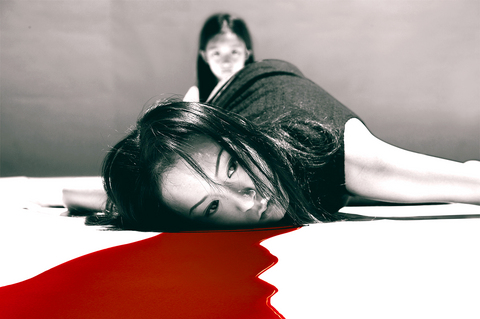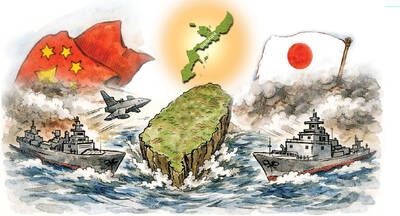Life and death. You cannot have one without the other. Both are on the program of Cloud Gate Dance Theater's (雲門舞集) spring program, which begins next Friday at the National Theater.
The beginnings of spring, the sudden bursting of cherry blossoms, are vivid reminders of life. Cloud Gate's performances will make you think about the joy of life, but also how ephemeral life is and about death.
Artistic director and founder Lin Hwai-min (林懷民) has put together a show that is very unlike any of the company's previous offerings. Its the first time Cloud Gate will be performing without one of Lin's creations, the first time that Cloud Gate 2 dancers will be performing at the National Theater, the first time that a non-Taiwanese has choreographed a work especially for Cloud Gate.

PHOTO COURTESY OF CLOUD GATE
For the first half of the program, the women of Cloud Gate Dance Theater will be performing in the world premiere of British choreographer Akram Khan's Lost Shadows. The second half will be Wu Kuo-chu's (伍國柱) 70-minute masterpiece, Oculus, performed by Cloud Gate 2.
Khan and Wu are young choreographers whose careers Lin has followed almost from the beginning. He said he wanted a different perspective this year: "Akram and Wu, they are really dealing with everyday life, speaking from a young person's point of view."
He had first asked Khan to do something for the company back in 2002, while Wu had choreographed On the Heights for the company in 2004, as well as several pieces for Cloud Gate 2.
Khan said Lin had told him "just do whatever you want."
He said he sketched out four or five plans: "Something based on a museum, on Lin Hwai-min's paintings … [I was] testing out ideas in workshops in other countries. The concept of death — how different people are with death."
He was looking for a story that would be both personal and universal. He said he had been influenced by the movie The Da Vinci Code — the power of the female, which is why he is only using women in the piece. British government advertisements against drunk driving were another source of inspiration.
"The story is based on one person who does not want to accept death but she is seeing her own body — she's in between heaven and earth — she's trying to figure out how she came to be in this crash, this accident," Khan said. "While she tries to replay what happened just before her death, she sees a friend who died. A car hit her — she didn't want to die, it was chosen for her — but she reminisces about her friend who committed suicide by running in front of train in childhood."
"She was running toward death, not knowing she was going to have an accident but her friend was running away from life," he said.
Khan said he frequently thinks about death — there's a lot of it in the world right now with the war in Iraq, bombings, other conflicts — but he's not morbid about it.
"For me it's a life, a form of therapy to create a piece of work — a way of dealing with what's happening in the rest of the world," he said. "In order to understand death you have to understand life. In order to understand life you have to understand death."
Death's shadow also hangs over the second work on the program, Oculus, but it the shadow of a life ended far too soon. Wu died in Taipei in January 2006 at age 36 after a 16-month battle with leukemia. He had taken the European dance world by storm in just a few short years. He as diagnosed with the disease just a few months after taking the job as artistic director of the Staatstheater Kassel Dance Company in Germany.
Lin wanted to stage Oculus as both a memorial to Wu and to help his youngest dancers, who were hit not only with the death of Wu, whom many saw as a big brother, but by the death of their company's founder and artistic director, Lo Man-fei (羅曼菲) a few months later. But even more, he wanted to ensure that more people have the chance to see Wu's work.
"It's [Oculus] a landmark work. I wanted to challenge those that come after him and challenge the dancers," he said. "When he passed away I invited three dancers from Kassel — classmates and friends from Essen — to come last summer for three weeks of intensive rehearsal."
"Wu was born in southern Taiwan, a lower middle-class family — you don't expect anyone from that village to become a great artist … he had such energy … he was so young," Lin said.
He also came to dance in a very roundabout way. Wu was a theater major at university and didn't start his dancing career until he entered the Folkway Hochshule in Essen, Germany, at 24. He began choreographing at 27.
"He was a fatso. He started dance classes at university to lose weight," Lin said. "He got the theater department kids to take ballet — this fat guy really struggled at the bar — even in his last days he loved ballet … he would come out of the hospital to give Cloud Gate 2 ballet class. He would plead with the doctors, we would send a car for him."
"He was wonderfully sensitive to music — very rare among young choreographers," Lin said.

Most heroes are remembered for the battles they fought. Taiwan’s Black Bat Squadron is remembered for flying into Chinese airspace 838 times between 1953 and 1967, and for the 148 men whose sacrifice bought the intelligence that kept Taiwan secure. Two-thirds of the squadron died carrying out missions most people wouldn’t learn about for another 40 years. The squadron lost 15 aircraft and 148 crew members over those 14 years, making it the deadliest unit in Taiwan’s military history by casualty rate. They flew at night, often at low altitudes, straight into some of the most heavily defended airspace in Asia.

Taiwan’s democracy is at risk. Be very alarmed. This is not a drill. The current constitutional crisis progressed slowly, then suddenly. Political tensions, partisan hostility and emotions are all running high right when cool heads and calm negotiation are most needed. Oxford defines brinkmanship as: “The art or practice of pursuing a dangerous policy to the limits of safety before stopping, especially in politics.” It says the term comes from a quote from a 1956 Cold War interview with then-American Secretary of State John Foster Dulles, when he said: ‘The ability to get to the verge without getting into the war is

Beijing’s ironic, abusive tantrums aimed at Japan since Japanese Prime Minister Sanae Takaichi publicly stated that a Taiwan contingency would be an existential crisis for Japan, have revealed for all the world to see that the People’s Republic of China (PRC) lusts after Okinawa. We all owe Takaichi a debt of thanks for getting the PRC to make that public. The PRC and its netizens, taking their cue from the Chinese Communist Party (CCP), are presenting Okinawa by mirroring the claims about Taiwan. Official PRC propaganda organs began to wax lyrical about Okinawa’s “unsettled status” beginning last month. A Global

Like much in the world today, theater has experienced major disruptions over the six years since COVID-19. The pandemic, the war in Ukraine and social media have created a new normal of geopolitical and information uncertainty, and the performing arts are not immune to these effects. “Ten years ago people wanted to come to the theater to engage with important issues, but now the Internet allows them to engage with those issues powerfully and immediately,” said Faith Tan, programming director of the Esplanade in Singapore, speaking last week in Japan. “One reaction to unpredictability has been a renewed emphasis on